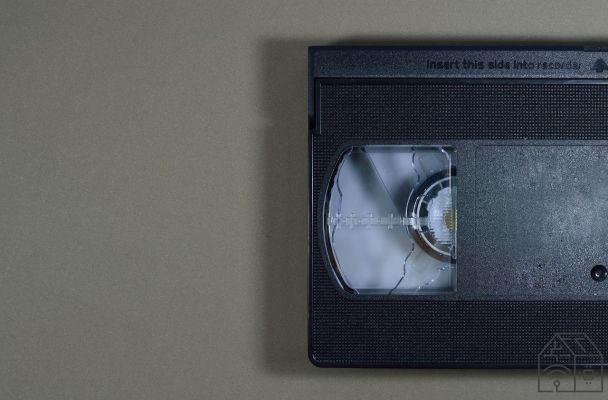
In this historical period it is difficult to imagine our daily life without being able to benefit from a audiovisual product, a movie or a series, from the comfort of our home. Yet this privilege to become such has undergone a process, growth, changes and diversifications, especially in recent years when mass media circulation has increased dramatically.
However, this luxury did not become a reality until the mid-70s, when home cinema existed only for those who could afford cinema projectors, intended for home entertainment halls: in 1965, it was Eastman Kodak to market the film format Super 8mm, whose high price had a small niche market limited to cinema enthusiasts.
The overwhelming majority of people, in addition to in-room viewing of the films, could have enjoyed the films through the archives of a library, or awaited a film re-release, or on television, which meant having to watch an edited version, with commercial breaks and in a very specific time window.
How it has changed: the audiovisual market

Before eviscerating all audiovisual formats that have been released on the market, a necessary premise must be made: the audiovisual world, together with all the formats that have followed one another from the 70s to today, can also be identified with the expression home video, an expression precisely that identifies the whole range of products intended for reproduction technology and which allow the private or domestic use of audiovisual works. For years, the term home video has often been mistakenly associated with videotape and similar products.
In the era of 3D, gods Blu-ray and services streaming, which offer vast catalogs of new and classic films with one click, we often forget the long road that the audiovisual market has taken and which has led to the technological progress we are all used to. The history of home video is based on the legacy of a very specific technological process, which begins in the 70s. There first videotape it fits into a context and an era in which if you missed an episode of your favorite TV show there was no way you could recover it.
When the VHS, this device was nothing more than an appendage of the television, without which it would have had no functionality. A first format was the so-called VTR, invented in the 50s, a huge piece of equipment capable of recording video on a reel of film. However, instead of a small appliance, the VTR was a giant machine that cost a lot, in fact it was mainly used by TV broadcasters and professional studios. But its technology paved the way and led to more accessible and usable VHS in the future.
The audiovisual market and the VHS
Although tape recorders already existed on the market, mainly produced by Ampex and intended for television, the very first format was theU-matic dating back to 1971 and produced by Sony. The following year he would be introduced by the Philips theN1500, an ante litteram VCR, one of the first home recording systems whose biggest flaw was the short duration of the cassette, or 30 minutes. This detail came from the use made of it above all by operators in the television sector, that is a device made up of short tapes capable of rewinding in a fast and transmissible way in a short time.
The other change that VHS brought about was the recording of movies and TV shows straight from the television. Before that, home ownership of movies simply didn't exist. As home use continued to grow, some film studios initially held back from making all their old catalog classics available to the rental market, fearing that video would annihilate cinema attendance. For many years the videocassette has had a primary role among the audiovisual supports, from the 70s until the '95, the year of the birth of DVD.
The first video recording system available on the market, and which changed the world of entertainment, was the Betamax, which only preceded VHS by a few years. It took only a year for the Victor Company of Japan (JVC) to produce their own videotape. Between the two systems, VHS and Betamax, a real war broke out, later won by VHS which became the dominant system for home recording. It came on the market in three models: the 180-minute, 240-minute and 5-hour cassettes.
Betamax e VHS

Recording time has been an important factor in VHS dominance at Betamax. There Sony Betamax he was a descendant of the television studios; it initially only had one hour recording time, compared to 2 hours on VHS, but Betamax boasted slightly better picture quality. VHS managed to take over the video production market, putting a cheaper machine on sale - the lower price also meant more availability for people to choose from. Sony eventually relented in 1988, producing its own VHS player, which marked the end of Betamax.
In the 80s a third device entered the competition, but did not last long: the Video2000, developed by Philips and Grundig, a cassette capable of recording on both sides, as was the case with cassette tapes. Nonetheless, it was short-lived, as it was withdrawn from the market in 1989, just nine years after its release.
Videotapes were used until the early 2000s. In those same years, in addition to the Betamax and Video2000 formats, there was another format that exploded in the late 90s and was defeated by VHS, namely the laserdisc, one of the earliest optical disk storage technologies. The Laserdisc is a disc with recorded images and sounds: the material recorded on the video disc is printed in the same way that CDs are produced.
Laserdisc and Video2000
Laserdisc technology was invented by David Paul Gregg and James Russell in 1958, nearly 40 years before the first DVDs were released to the market. In 1980 Pioneer Corporation bought the patent and the licenses, becoming the owner of the brand, and the successful year commercialized, for the Japanese market, the first model Pioneer LD-1000. Laserdiscs were never widely accepted as the discs could not be used for recording and viewers were satisfied with the videotape due to its recording capabilities.
Laserdiscs were later replaced by the DVD format which was based on a two-layer CD. The DVD format was easier to manage and cheaper to produce than a laserdisc or even VHS tapes. By the time DVD was released in 1997, the Laserdisc format had virtually disappeared in many parts of the world.
But the real audiovisual revolution took place thanks to the trade of the first DVD, in 1995, a device that allowed a much better image quality than previous media, taking entertainment and the quality of home use to a higher level. . The DVD is the product of cooperation of some of the major consumer electronics companies: Philips, Sony, Matsushita, Hitachi, Warner, Toshiba, JVC, Thomson e Pioneer.
How it changed: the DVD

These discs were capable of showing movies with stunning quality picture and sound, with a significantly longer duration than tape. The desire of the companies was to create a format that all producers would embrace, thus avoiding competition between formats as had happened during the introduction of videotapes.
The biggest evolution in the audiovisual market took place thanks to the diffusion of Blu-ray, an optical media that appeared in 2002, and which is still today a excellent support of high definition tv. Blu-ray contains more data than DVD, 12 times more. Before Blu-ray, the digital optical format that sought to become the standard for DVDs was HD DVD. However, Sony tried to go against this technology by conducting a marketing campaign that turned out to be a success. In 2007, Blu-ray began selling more than HD DVD, until the following year, it disappeared from the market after Toshiba officially announced the discontinuation of the HD DVD project.
The audiovisual market and Blu-ray
Certainly what has produced a real reversal in the audiovisual market in recent years is streaming, a completely new way to enjoy the home entertainment experience. One of the first companies to excel in the internet distribution of movies, television series and other paid entertainment content is Netflix. Founded by Reed Hastings and Marc Randolph on August 29, 1997 in Scotts Valley, California, Netflix started out as a DVD rental business, where users could reserve discs on the internet, receiving them at home via the postal service. Since 2008, the company has activated an online on demand streaming service, which has changed the way millions of people spend their free time.
Streaming has revolutionized the way we watch movies, TV series, acting in a constantly evolving space, which allows viewers to have the total control over vision, choosing the format and device on which to watch the audiovisual product, and being freed from interdependence with a tangible object. In the years to come, most of these forms of entertainment will continue to evolve and change, shaping a new world in which digital content will take on an increasingly important role in our daily life.




















![[Review] Samsung Powerbot VR7000: the robot vacuum cleaner from Star Wars](/images/posts/6bc44de38605b5c0fa12661febb1f8af-0.jpg)





